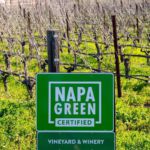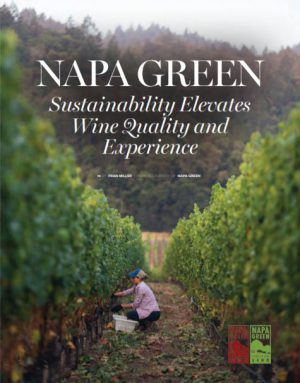
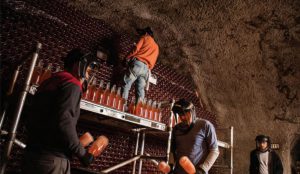
Sparkling wine bottles being unstacked and prepared for riddling, within the historic Schramsberg caves. Photo by Sarah Sanger Photography

Sheep serve as natural lawn mowers and fertilizers between the vine rows at Tres Sabores Winery.
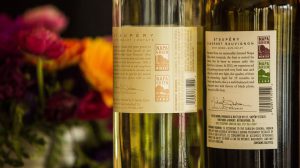
St. Supéry Estate features the Napa Green logos on all of their labels, inspiring conversations with visitors and trade.
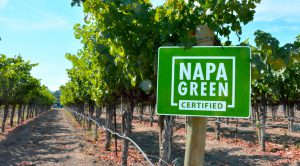
Keep an eye out for the Napa Green Certified signs as you travel through the Napa Valley.
Napa Green: Sustainability Elevates Wine Quality and Experience
- FRAN MILLER | Napa Valley Life Magazine |
- March 26, 2020
Napa Green Land certification entails that land owners assess all aspects of their property, including farming practices, roads, and waterways, and that they implement measures to retain soils and prevent erosion, identify and reduce harmful inputs and runoff, conserve water resources, and preserve habitat along the river, creeks and streams. To become a Napa Green Certified Winery, wineries must implement 100+ measures to improve energy and water efficiency, prevent waste and take climate action – all while engaging employees on the path to winery sustainability. Napa Green provides the opportunity for ‘soil to bottle’ stewardship that contributes to the health of the Napa River watershed, integrates resource conservation and climate action into day-to-day operations, implemented by vineyards and wineries committed to being conscientious employers and good neighbors. It’s a tall order, so it is impressive that there are now nearly 90 Napa Green Certified Wineries. Roughly 70% of Napa Valley’s vineyard acreage has been certified Napa Green Land, representing more than 30,000 acres.
“Winery participation in either of these two certification programs is totally voluntary,” said Anna Brittain, who, as executive director of Napa Green, works closely with each winery to achieve certification. “The effort is often led by whomever has a passion for sustainability – be it the winery’s winemaker, operations manager or proprietor. The Napa Valley Vintners, who have championed the program for more than 15 years, set a goal to have all of their members participating in one or both programs, and we are more than 75% of the way to meeting that goal. Right now, 40% of all certified sustainable wineries in the whole state are located within Napa. We are extremely proud of our industry’s leadership.”
The self-guided itineraries each feature three, close-in-proximity wineries with shared qualities. An art lover? Choose Art & Architecture and taste as you tour the galleries of Etude, Artesa, and the Hess Collection. Select the American Dream itinerary and learn the origins of Chateau Montelena’s historic 1976 Judgment of Paris win, absorb Benessere’s ‘good life’ vibes, and witness how a wine dynasty family keeps things fresh at Trinchero Napa Valley. The Eco Chic tour leads to the rustically elegant tasting barn of Phifer Pavitt, the stylish solitude of Stony Hill, and exploration of the geological history of the Napa Valley via a private tasting experience 65 feet below the earth in the Chateau Boswell Caves.
Making the commitment to third party certification takes time and effort, but it is worth it to demonstrate our commitment to the community and to protect our watershed, our land and the air we breathe.
- Susan Boswell, Chateau Boswell Winery

